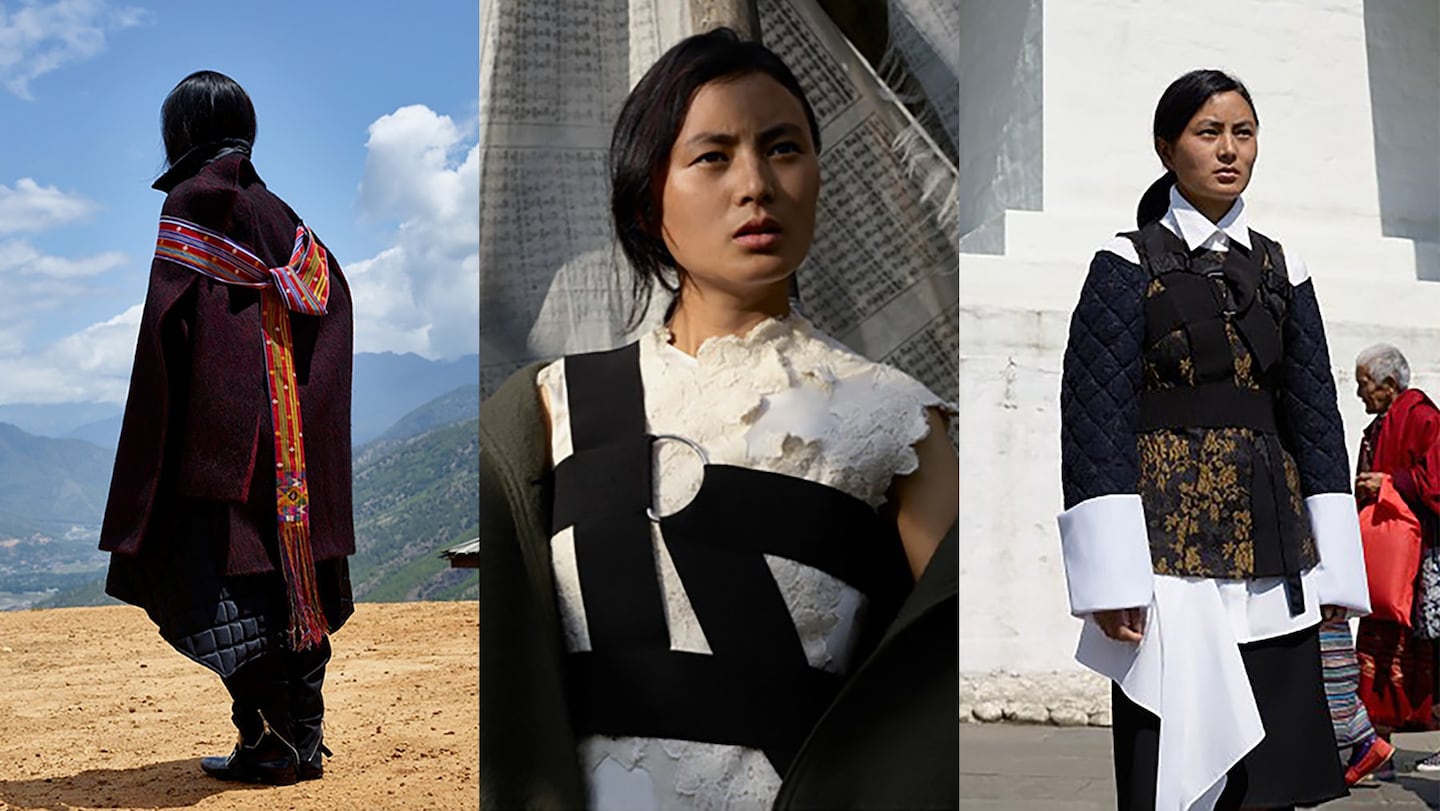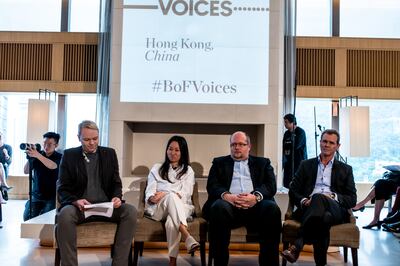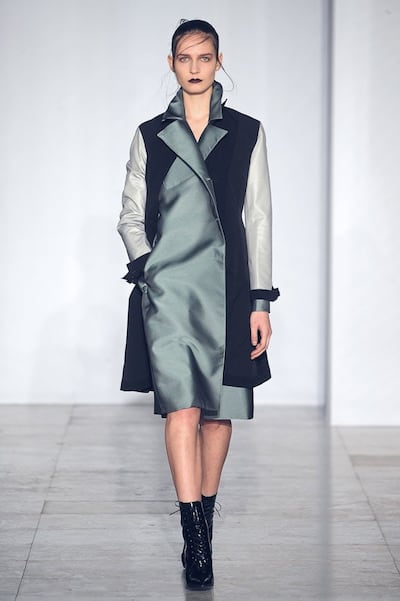
The Business of Fashion
Agenda-setting intelligence, analysis and advice for the global fashion community.

Agenda-setting intelligence, analysis and advice for the global fashion community.

The new era of Chinese manufacturing was one of the topics discussed at BoF’s recent VOICES event in Hong Kong. Stay tuned for more from VOICES, a series of invitation-only events on the fashion industry’s most burning issues, leading up to a special global gathering to take place in London in December 2016.
HONG KONG, China — "When I arrived in '97, there wasn't even a highway from Hong Kong into the Pearl River Delta so it took us hours to get [to our factory in neighbouring Guangdong Province]. I thought, my God, why did I end up here? But then, China went into turbo mode," said Gerhard Flatz, the Austrian managing director of KTC, a manufacturer of premium sportswear in China.
Back then, KTC was like many other Chinese clothing factories operating on a mindboggling scale. Apparel brands like Adidas — just one of the firm’s many clients — would regularly dispatch orders for millions of garments to be churned out at KTC’s factory in Heshan, a small city outside Guangzhou. As far as the eye could see, identical garments would whisk along the assembly line in a tedium of mass efficiency.
Founded in the late 1970s by another adventurous Austrian, Hans Kremmel, with the help of a Chinese partner called Luo Shineng who had close political connections, KTC rode the wave of market economy reforms unleashed by Deng Xiaoping. The former Chinese leader’s reforms opened up the country to international trade and kickstarted China’s metamorphosis from industrial backwater to “the factory of the world.”
ADVERTISEMENT
Over the past 25 years, China’s share of global manufacturing output has risen from 3 percent to nearly 25 percent by value, and if you take into account the supply chains that Chinese firms drive across other parts of Asia, then that figure rises to nearly 50 percent, according to data released by The Economist.

Fashion industry leaders explore the future of the Chinese market at BoF VOICES event in December 2015.
When it comes to global fashion manufacturing output, China’s share is even greater. Producing 60 percent of the world’s shoes and exporting over 43 percent of the world’s clothing, China has become indispensable for designers, brands and retailers across the globe from fast fashion to luxury. Given the fact that Greater China now produces nearly eight times more clothing than its nearest rival Italy, the old guards across the fashion capitals grudgingly concede that much of the fashion system would grind to a halt without Chinese supply chains.
But like many other manufacturing sectors, China’s colossal apparel, footwear and textile industry is currently facing a cocktail of challenges. Higher production costs and rising wages are squeezing them on one end, while competition from cheaper sourcing hubs in Asia and Africa and a global economic slowdown burden them at the other.
At a time when the Chinese government is introducing policies to tilt the economy, from manufacturing to services and creating a tougher regulatory environment, there is no doubt that China’s fashion manufacturing sector is under pressure. For firms like KTC, however, the recent upheaval has simply hastened an evolution that was already under way.
Innovation, Specialisation and Upgrades
Chinese manufacturers are becoming leaner, more technologically advanced and innovative. While a few find success through diversification, others are moving up the value chain with a more specialised strategy and offering. Investing in high-tech upgrades rather than economies of scale, a new generation has shifted to producing fewer units but at higher profit margins.
“What we’re going through during this up-trading phase is leaving our old stage behind as a big manufacturer. Now it's about becoming a boutique manufacturer. So instead of style quantities in the several thousands, we're talking about a quantity of 20 pieces per style now,” said KTC’s Flatz, who recently began collaborating with smaller fashion designers in Europe, like the capsule collection he produces for Yang Li, which is distributed to retailers such as L'Eclaireur in Paris and Barneys New York.
ADVERTISEMENT
KTC stopped producing for giants like Adidas ten years ago when it moved away from the sportswear mass market. By focusing on activity-specific technical apparel, specialist athletic gear and upmarket performance wear, Flatz has attracted clients like cycling lifestyle brand Rapha, Mammut, Mustang Survival, Gore Running Wear and apparel brands that cater for niches like mountaineering, trekking, sailing, skiing, equestrian and extreme sports.

Yang Li Spring/Summer 2016, powered by KTC | Source: Yang Li
“We have to go into a kind of micro-economy in manufacturing, away from those long sewing lines. Our largest sample room today is only 2,000 people,” he said, adding that the firm’s annual manufacturing output now peaks at around two million garments. While the current business model requires higher R&D investment and more extensive lab and field-testing, the payoff can be measured in more ways than just a higher profitability ratio.
Because firms like KTC are moving into a narrower tranche of the market, there are fewer competitors who can match their specialist know-how. And since their business is now based more on expertise than on volume selling at cutthroat prices, they are able to invest more time and money on issues like compliance, productivity, transparency and sustainability.
“Being premium payers in this industry is helping us… By paying more, our people are more efficient, because they’re more motivated. And because of this, a lot of the talent stays longer, and the longer they stay the more efficient they get,” Flatz explained at BoF's Fashioning China's Future event in December in Hong Kong.
"Our five year plan is that, as salaries are increasing all over China, we want to employ 80 percent locals behind the machines and reduce migrant labour to 20 percent," he added, referring to the plight of waidiren, the country's long-term internal migrants who have struggled under the once rigid hukou registration system in cities where they reside.
After joining the Fair Labour Association, KTC conducted an internal satisfaction survey last year to measure the happiness of its workforce, and began making improvements. Such activities may seem unusual in a country where poor worker conditions still regularly make the headlines but more firms like KTC are gradually becoming more attuned to worker welfare and ethics.
Offshoring and Outsourcing
ADVERTISEMENT
The global fashion sourcing map has gone through a lot of changes in the past decade. Lower labour costs in Africa and parts of Asia have begun to attract major fashion players to new manufacturing frontiers. The Chinese are often a lynchpin in the development of these emerging hubs.
Chinese garment and textile producers have become the most deeply embedded in the supply chains of South East Asia, building, acquiring or partnering with production facilities in places like Vietnam, Myanmar and Cambodia, while making strategic partnerships in Indonesia and Bangladesh. KTC, for instance, runs a satellite factory in Laos.

Yang Li Spring/Summer 2016, powered by KTC | Source: Yang Li
The Chinese have been flexing their muscle further afield too. Some have reportedly made a fortune in the Middle East through the Qualified Industrial Zones located in states neighbouring Israel, like Jordan, where they gain duty-free access to the American market. Chinese firms like Keer have even come circle by moving their yarn and textile mills to American states, like South Carolina, where cotton is relatively affordable.
According to data compiled by policy researcher Cyrus Yu, Chinese factories are also expanding across several African countries. Shoe companies like Huajian and Hazan operate in Ethiopia and Nigeria, respectively, while textile firms such as Jiangsu Lianfa are entering Kenya, Uganda and Tanzania.
One intrepid Chinese tannery facility has even set up in Somaliland, the breakaway region of war-torn Somalia, although it has since been accused of environmental and ethical malpractice. Human Rights Watch has documented other cases of Chinese factories falling foul of safety regulations, labour laws and human rights issues in new manufacturing frontiers.
Critics cite the “dumping” of cheap Chinese apparel as a threat to local producers and describe the expansion of Chinese factories in less developed countries as a ruthless “race to the bottom” for the cheapest labour. Supporters say that China’s investment in emerging manufacturing centres can have transformative effects on local economies by spurring industrial development and bringing a wage to impoverished people with few other options.
Either way, the Chinese are not alone in their quest to offshore production to more affordable frontiers. Around Africa, Chinese factories and mills are increasingly in competition with Indian, Turkish and other producers, while in Asia they vie with European, American, South Korean and Japanese firms.
Enhanced Productivity and Improved Quality
In spite of all this activity abroad, experts remain confident that neither international affiliates nor international competitors will jeopardise China’s dominant position in the short term.
“The single largest country for sourcing at Li & Fung is still China. It’s on a massive scale and still represents 47 percent of everything that we source. Consider that we're sourcing just shy of $15 billion at FOB [prices], so [China’s portion of this] is a massive number,” said Rob Sinclair at the BoF VOICES event in Hong Kong in December.
Sinclair is the chief operating officer of LF Sourcing, a division of global supply chain manufacturer Li & Fung. The firm manages global supply chains of high-volume, time-sensitive goods for some of the world’s biggest fashion brands and retailers across a network of 15,000 suppliers in 40 countries.

Yang Li Spring/Summer 2016, powered by KTC | Source: Yang Li
“Let’s face it, the Chinese have created an incredible supply chain infrastructure. Now the question is who else around the world can copy it. I don't frankly think that anyone will be able to come anywhere close, because of the verticality that exists in China. They have cotton, spinning, dyeing, textile expertise, everything,” explained Sinclair.
“India is an interesting conundrum because if there’s any other country that could compete, it would be India. They have [all the links in the supply chain] and a huge labour pool like China's but in terms of exports, India almost doesn't even rank. We have a lot of business flowing through India but it's very much challenged by its infrastructure,” he added.
China is continuously developing both the hardware and the software needed for its rapid, sophisticated supply chains. Its internal transportation network, power sources and world-class ports are more reliable and efficient than those in India and other less developed sourcing countries. Another advantage is the ‘clustering’ effect of interdependent factories of China that feed components and materials to one another in dense manufacturing areas like the Pearl and Yangtze River Deltas. Clusters like these ease logistics and drive down costs.
"As a brand, we're asked to deliver nine times a year and to do it quickly, [so] to me, the most important thing when choosing a manufacturing facility — besides [quality] and the relationship — is speed to market and minimising freight costs," said Wen Zhou, chief executive officer of 3.1 Phillip Lim, the New York-based fashion brand that is made entirely in China, at the BoF event.
Technology, automation and advanced robotics are now contributing to China’s ability to remain price competitive. “They are mitigating cost increases by doing things smarter and better. They have the technology, they have the will and then you have the software of China’s skills and its well-trained workforce,” said Sinclair.
“You can go to a number of factories in China and you've got Italians and various other European technicians and experts working within these facilities. They've embraced that. You don't see that same scenario in India or Bangladesh and loads of other countries — not yet, at least,” he added.
“The production leaving China [to these countries] tends to be the volume-driven basic products. So we don't necessarily see the overall future of China and its role [in apparel production] diminishing,” Sinclair said.
Indeed, the biggest advantages many cite for China’s continued supremacy in are skills and productivity. According to Deloitte’s 2016 Global Manufacturing Competitiveness Index, China remains at the very top. Although the auditing firm predicts that the US will overtake China in five years, China will continue to outshine most of the Asian nations currently vying for a bigger slice of the manufacturing pie. India, Vietnam, Malaysia will become more competitive but China will still be miles ahead.
"With such a large, skilled workforce in China, Europe faces a tough task competing too," said Flatz. “Because now the West is struggling to compete with the East, not just on price, but also on quality, something which hasn't always been true.”
To learn more about VOICES, BoF's new annual gathering for big thinkers, visit our VOICES website, where you can find all the details and apply to attend our invitation-only global gathering in December, in partnership with QIC Global Real Estate, hosted at the Soho Farmhouse in Oxfordshire in the picturesque English countryside, one hour from London.
With consumers tightening their belts in China, the battle between global fast fashion brands and local high street giants has intensified.
Investors are bracing for a steep slowdown in luxury sales when luxury companies report their first quarter results, reflecting lacklustre Chinese demand.
The French beauty giant’s two latest deals are part of a wider M&A push by global players to capture a larger slice of the China market, targeting buzzy high-end brands that offer products with distinctive Chinese elements.
Post-Covid spend by US tourists in Europe has surged past 2019 levels. Chinese travellers, by contrast, have largely favoured domestic and regional destinations like Hong Kong, Singapore and Japan.